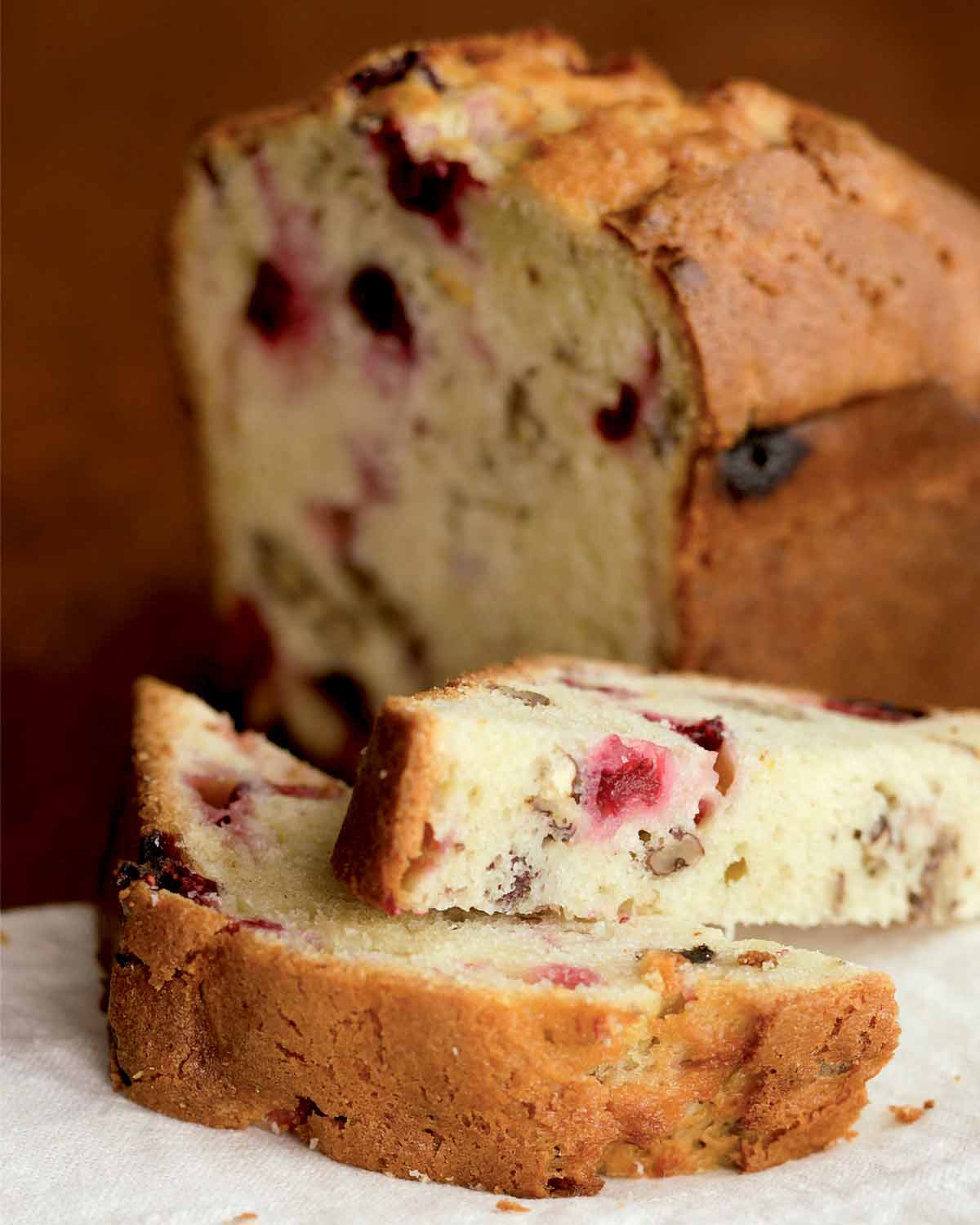
This cranberry orange pecan bread has a subtle sweetness and slight tartness that makes it a welcome respite from whatever you’re doing any time of day, any time of year. It also makes a terrific gift, which is why the recipe makes not one but two loaves—one to gift, one to keep.–Renee Schettler Rossi
*How to bake with cranberries
We’re quite smitten with the jarring tartness that happens when you bite into a burst of cranberry in this cranberry orange bread. But don’t be tempted to leave the cranberries whole in this recipe or any quick bread or coffee cake recipe. Why? Whole cranberries tend to float to the surface rather than staying pleasingly dispersed throughout the baked good. Simply pulse the cranberries in your food processor until coarsely chopped but not mushy and then toss them in your quick bread batter. [Editor’s Note: We advise against attempting to chop fresh cranberries with a knife on a cutting board given just how maddeningly roly-poly they can be. It’s not only frustrating but dangerous.]
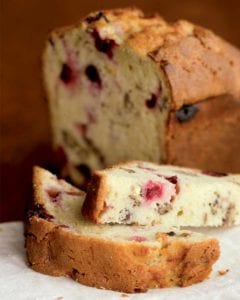
Cranberry Orange Pecan Bread
Ingredients
- 3 1/2 cups all-purpose flour, plus more for the pans
- 1 1/2 teaspoons salt
- 3/4 teaspoon baking soda
- 1 1/4 cups buttermilk, (either low-fat or full-fat)
- Zest and juice from 1 large orange, preferably organic (about 1 1/2 tablespoons finely grated zest plus 1/4 cup juice)
- 1/2 teaspoon vanilla extract
- 2 1/4 cups granulated sugar
- 3/4 cup mild vegetable or olive oil, plus more for the pans
- 3 large eggs, lightly beaten
- 1 3/4 cups cranberries, fresh or frozen (do not thaw if using frozen cranberries)
- 1/2 cup pecans, lightly toasted and coarsely chopped
Instructions
- Preheat the oven to 350°F (175°C). Lightly oil and flour two 9-by-5-inch loaf pans.
- In a large bowl, whisk together the flour, salt, and baking soda.
- In a smaller bowl, whisk together the buttermilk, orange zest and juice, and vanilla.
- Using a stand mixer fit with the paddle attachment, beat the sugar and oil on medium-high speed until thoroughly combined and somewhat sandy. Reduce the speed to low and slowly add the eggs. Increase the speed to medium and continue to mix for 2 minutes.
- Reduce the speed to low again and add 1/3 of the flour mixture, mixing just until incorporated. Increase the speed to medium and mix for 1 minute. Add half the buttermilk mixture and mix briefly to incorporate. Repeat with the remaining buttermilk mixture and the remaining dry ingredients, beginning and ending with the flour mixture, scraping the sides of the bowl as necessary and stirring only as long as is required to completely combine the ingredients.
- Coarsely chop the cranberries in your food processor. (See *How to bake with cranberries" above.) Gently stir the cranberries and pecans into the batter, being careful not to overmix. Divide the batter evenly between the prepared pans so that each is slightly more than half full.
- Bake the cranberry orange pecan bread, rotating the pans every 20 minutes or so, until the loaves are golden brown with cracked tops and a skewer inserted in the center comes out clean. You want to start checking the bread at 45 minutes, although it could take as long as 75 minutes.
- Let the breads cool in the pans for at least 10 minutes. Turn the loaves onto a wire rack to cool completely before you slice and demolish.
Notes
How To Make Cranberry Orange Pecan Muffins Or Mini Loaves
If you prefer to make muffins or mini loaves of cranberry orange pecan bread to gift, simply divvy the batter among 12- to 18-cup muffin tins or 6 mini-loaf pans and start checking for doneness after 15 minutes for muffins, 25 minutes for mini loaves. If you have a convection oven, you can turn that on during the final few minutes to lend the muffins or mini loaves a golden color.Nutrition
Nutrition information is automatically calculated, so should only be used as an approximation.
Recipe Testers’ Reviews
Polish your best silver tray. This cranberry orange pecan bread deserves royal treatment. It’s the right kind of quick bread to serve along with your holiday spread. Morning, noon, or night, this bread is for any hour of the day when you just want to spoil yourself or your guests. Citrus scents and tart cranberries make this loaf a joy to eat.
You can make it in short order, and it’ll keep moist for days, or you can freeze it for later. Just be sure to pick up extra bags of fresh cranberries in the fall and freeze them. One loaf won’t be enough because your silver tray won’t stay full for long.
It’s beginning to look, taste, and smell a lot like Christmas. That’s how we feel every holiday season when I’m making this flavorful, extremely moist bread. I have been making this recipe for years.
It makes 2 loaves of bread, which ordinarily I would be hesitant about. Two loaves of bread for two people. Here it’s not at all a problem. Actually, it’s a necessity. One loaf we eat fairly quickly after I make it. I slice the other loaf of bread, wrap each slice separately, freeze each one, and then vacuum-seal the slices once they are frozen in one of those heavy bags made for such a purpose. All through the year, when we want to feel festive, or just have a special treat, we defrost a slice or two, and it’s Christmas morning all over again.
And, if the slices don’t make it till the next Christmas, I just make more bread. That’s enough of a reason to freeze a bag or two of fresh cranberries when they are available. Just don’t defrost them before using.
I use 1/4 cup of tangerine juice for this recipe because that’s what we tend to have in the refrigerator.
I slice the cranberries by hand. I hold each cranberry between my thumb and index finger with my left hand, and then cut each cranberry in half diagonally with a sharp knife with my right hand. This works very well, goes very quickly, and my pieces have some substance.
It’s so nice when everything in a recipe works as expected and what you see is what you get…and what you get here is a remarkably moist quick bread (thanks to eggs, buttermilk, and olive oil), scented with orange and flecked with chunks of cranberry and pecans. I recommend making this recipe the day before, because the flavor is at its peak when it’s had some time to rest after baking.
For me, the batter made one 9-by-5-inch loaf and seven 4.5-by-2.5-inch mini-loaves, which I distributed throughout the neighborhood. The mini-loaves are adorable and great for gifting, but I imagine they’d make fantastic muffins as well. I’d offer to report back how the texture was after several days, but I already know it won’t last that long.
I recommend rubbing the zest into the sugar and letting it sit while you do the rest of your prep work. The sugar really helps draw the oils out of the zest, giving the sugar a light orange tint and really releasing the orange fragrance. This ensures the orange is evenly spread throughout your bread.
The mini loaves took 30 minutes (i turned the convection on the last 5 minutes to help color the top, which was a little pale at 25 minutes).
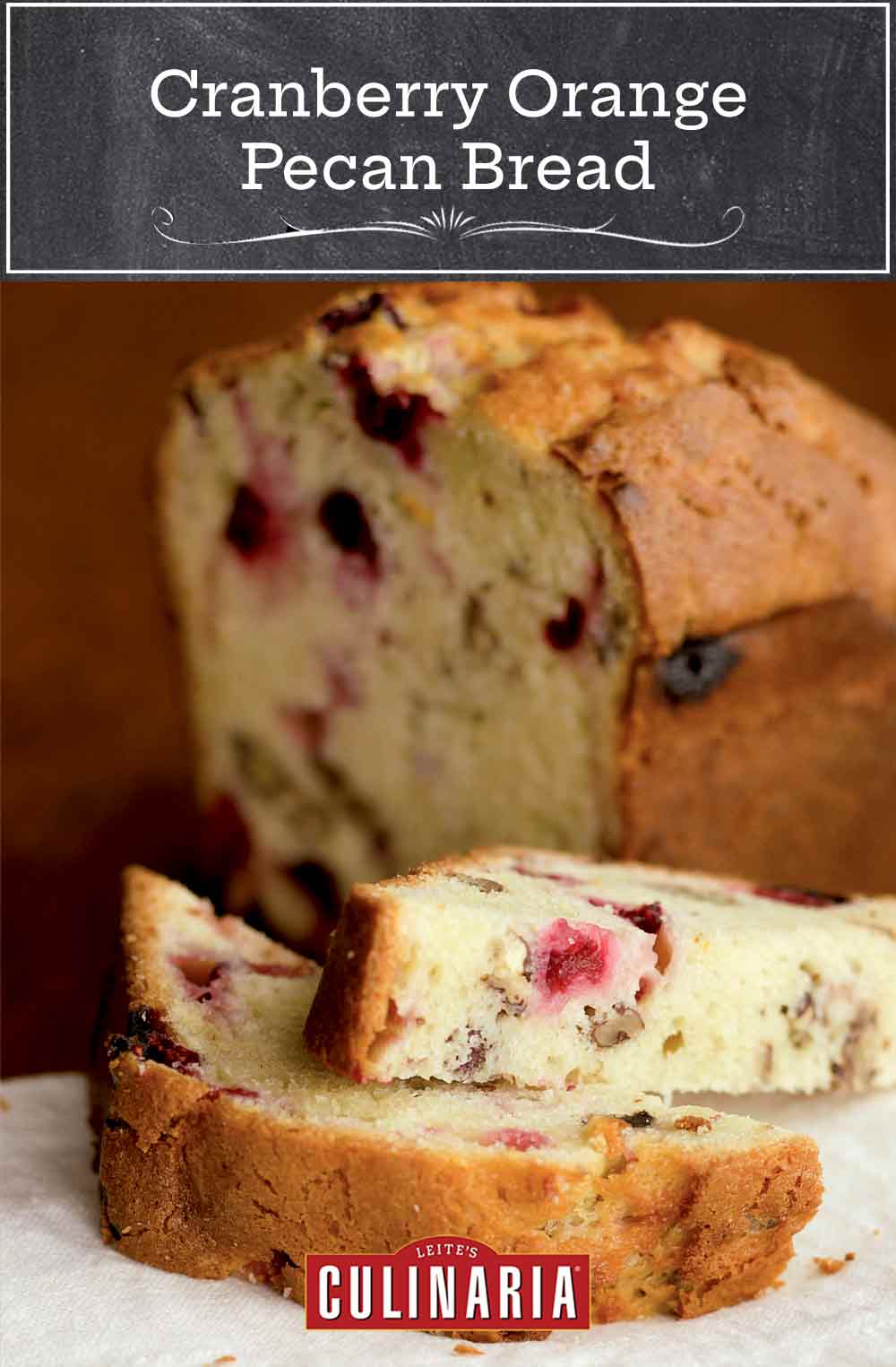



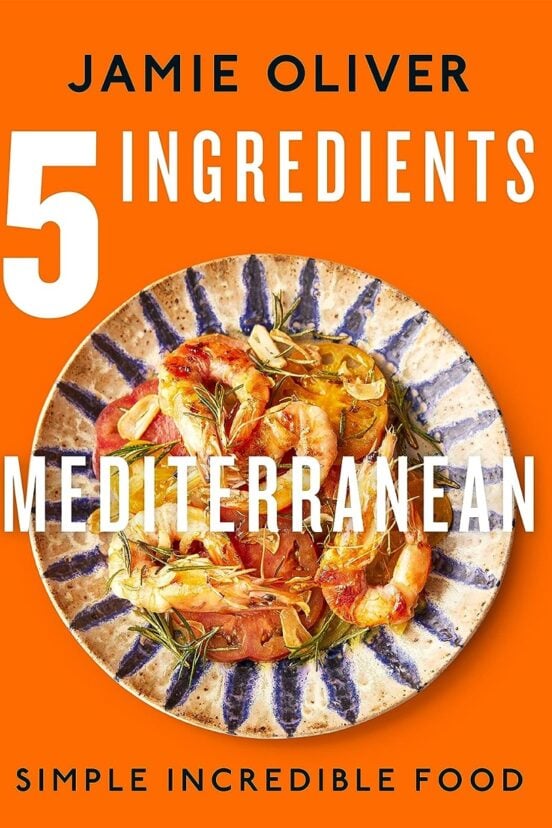
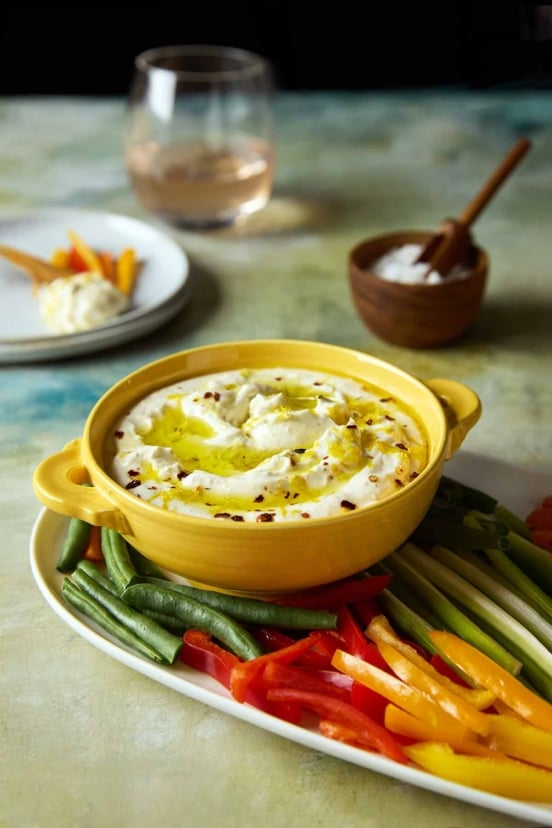
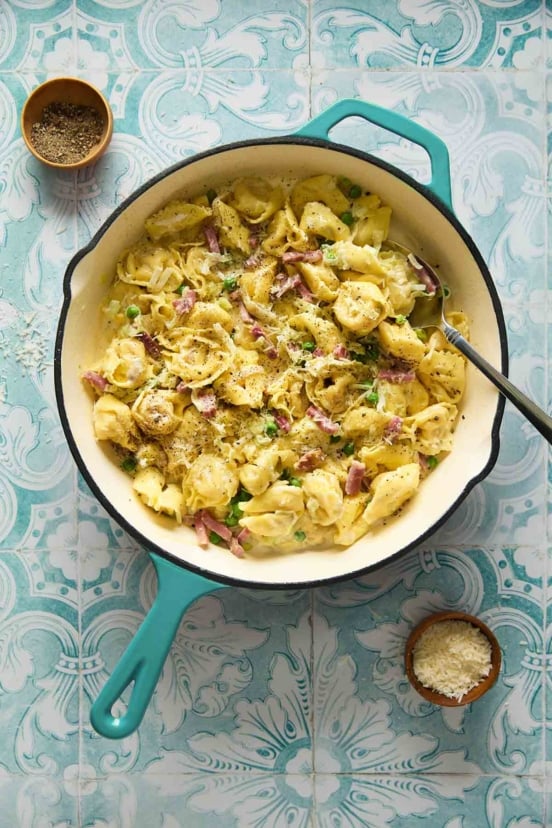









I can now stop trying cranberry bread recipes because I have found THE ONE and will be making this every year. The recipe is deceptively simple; the results are complex and irresistible. I love that I don’t have to buy sour cream or a special yogurt. Powdered buttermilk (which I always have on hand) works just fine. A bag of cranberries left over from Thanksgiving, after discarding the funky bits, yielded about 2-1/4 cups of berries, and I threw them all in. I had plenty of pecans in the pantry, so I used a full cup. I did need to microplane two oranges to get 1-1/2 T of zest. There’s a good bit of prep time (zesting, toasting, chopping…) but the return on investment is superb.
Thanks, Emma. We’re so happy to hear that you love this as much as we do.
Love this recipe! I soaked my cranberries in some spiced rum overnight, and it added just a touch of spice. The loaves were beautiful. I topped with a light lemon glaze. My husband declared it his new favorite.
How wonderful, Tracie! Love your tweaks!
I present to you the penultimate thing I baked in 2020: a batch of mistakes that somehow fits the end of the year. I started with this. I knew going in that I didn’t have any more pecans open, but I did have just the right amount of walnuts left in a bag. That swap should be pretty inconsequential. I also knew that I didn’t have an orange to zest and juice. I did, however, have a couple of satsumas earmarked for lunch. They’re too seasonal and precious to juice for baking, but zesting them before peeling and eating isn’t a problem. Furthermore, last I’d seen, there was still a bit more than a quarter cup of OJ hanging out in the open container in the fridge. So I zested the satsumas before lunch, and put the zest aside until I was ready to bake.
Fast forward to after lunch. I started as I always do, with mise en place. And when I looked in the fridge, I couldn’t find the open container of OJ. I knew we still had a new container, as I’d seen it when I’d retrieved the bag of cranberries from downstairs, but I didn’t want to open it just for a lousy quarter cup (and start the timer ticking on needing to use it all up sooner rather than later). So, next thought: add a bit of orange extract to the batter, to go along with the satsuma zest and amp up the orange flavor. I was pretty sure I had a bottle, and sure enough I found it in among the other extract bottles. And then I looked at it more closely: it was empty. It’s been a while since I used it, and it had apparently completely evaporated in the meantime (unless someone used it all up, put the cap back on, and put the bottle back on the shelf, and that would be a federal offense in my house!). Strike two! (I noted the branding on the empty bottle: King Soopers house brand. King Soopers is the name Kroger stores use in Colorado. I haven’t lived in Colorado since 1998, so this bottle predates then. Extracts apparently don’t go bad, they just evaporate away.) I considered juicing a lemon and using that, but lemon juice is so much more dominant than satsuma zest that I was afraid I’d overwhelm the zest, and I like orange and orange-adjacent flavors with cranberry much more than I like lemon with cranberry. I also considered orange flower water, but decided that it wouldn’t be acidic enough, and I didn’t want to screw up the baking soda leavening pH balance. In the end, I wound up just adding an extra quarter cup of buttermilk to the batter, which emptied out that container as well. I also added a quarter teaspoon of Fior di Sicilia, to at least get something else citrusy into the batter.
These days when I bake, I prefer to make things in individual servings whenever possible, as they’re easier to share out with local friends. Thus, I took a hint from the recipe and instead of baking two large loaves, I opted to do muffins instead. (I would have done mini loaves, but I only have 4 pans, not the 6 the recipe says I’d need.) I started by lining a 12-well muffin pan with paper cups, given that the guideline in the recipe suggests getting 12 to 18 muffins from a batch. And finally, I started in on the prep.
First up: toasting the nuts. Congratulate me, as I managed this without burning them. This may have been one of the few things that went right in 2020: twice over the course of the year, I managed to properly toast nuts. I even got them out of the pan and onto a plate to cool without overtoasting them.
Then the prep. It seemed really easy, until I realized that it was just about time to add the cranberries, and I hadn’t done anything with them yet. So I ripped open the bag, dumped the contents into a sieve, corralled a few rogue berries that bounced out to the countertop, and rinsed them under cold water before giving them a good shake (and bouncing a few berries out again). The recipe is (correctly) quite firm about making sure that the berries don’t go in whole, because they’re hollow and will float up to the top and stay there as they bake. The recipe also (incorrectly, IMHO) suggests using the food processor to take care of chopping the berries, as they didn’t want to be held liable for injuries caused by knives and rolling berries on a cutting board. (David Leite, you have never had to wash my food processor, a task far more dangerous than cutting berries. I instead cut the berries in half, securing each one between my thumb and forefinger with my hand bridged over the top, letting my paring knife slide in between as it sliced cleanly through and down to the cutting board, one berry at a time). FWIW, I measured 1 3/4 cups of cranberries as weighing 189 g. And then, I chopped the toasted and cooled nuts—but I didn’t want to get another knife dirty so I also did these one by one with the paring knife. This was significantly more tedious than halving cranberries, but the time was probably a wash versus having to wash a second knife.
Finally, the batter was ready. I went so far as to weigh the completed batter in the mixer bowl, subtract out the weight of the mixer bowl, and divide what was left by 12, so I knew how much batter I needed per muffin. It worked out to about 150 g. Thus, I zeroed out the scale, got my biggest disher, set up the lined muffin pan next to the batter bowl and scale, and took my first scoop out. My biggest disher held about 100ish g of this particular batter. I dished it into the first cup. It filled the cup to just about overflowing, even without adding the next 50 g. Clearly, I was going to be more on the 18-muffin train with this batch, especially since I noted that if 150 g per muffin would make 12 muffins, 100 g per muffin should make 18 muffins. Thus, I paused to get out and line my 6-cup muffin pan, ready to fill it also.
The trouble with muffin batter that has inclusions such as nuts and fruit is that muffins are rarely uniform from one to another; I found that about 90 g of batter, maybe a tad more, was enough to fill the cups as full as I was comfortable. After I filled all 18 wells in the two muffin pans, I still had batter left. I have a few muffin cups that stand on their own, no pan required. I put two of them on one of the trays from a previous toaster oven, filled the first one 3/4 of the way, and then decided what the heck, the rest of the batter can fit in this one also. (Spoiler alert: it did. No disasters. And I saved one of my stand-alone cups for another occasion.)
They all went into the oven, which I’d preheated to 350 °F as directed. This seemed low for muffins. As it turned out, it probably /was/ a tad low for muffins, although it would have likely been fine for loaves with the more extended baking time. (A quick skim of online muffin recipes shows that 425 or 375 is far more common for muffins than 350; my oven temp is accurate.) They took significantly longer than the recipe predicted for muffins, and didn’t get as much lift or browning as I would typically expect for muffins, even with the added oomph of the convection fan for the time after the first 15 minutes. Eventually a selection of the muffins tested done but pale, so I pulled them out of the oven, and after a couple of minutes, transferred them from their tins to a cooling rack.
As soon as was reasonable, I ate the one that had been baked in the standalone cup. The first thing I noticed was that mercifully, it released from the paper. The second thing I noticed was that the flavor was OK, passable, possibly even leaning towards good, with a really nice balance between the crunchy nuts, the bitter/sour berries, and the sweet muffin batter. And the third thing I noticed was that I really missed having a nice brown muffin top with a crispy edge. Thus, I can’t really call these muffins, but rather they’re mistakes that happen to look rather like muffins, and that’s what I’ve been telling the people I’ve shared with.
I’d make them again, as muffins—but I’d cut the recipe down to 2/3 (easy to do, given that the only quantized ingredient is the 3 eggs) and I’d boost the oven temp. And I’d maybe also make sure that I had OJ available!
Wow, Melissa, your experience certainly does seem to sum up 2020, in the form of a muffin. For what it’s worth, they look pretty tasty and we’re glad you forged ahead despite the many obstacles. We’ll look forward to hearing how they turn out next time around! Happy New Year.